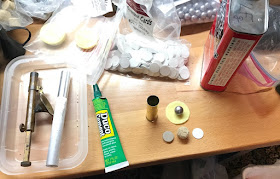This weekend I went camping with friends Nick and Ed at Nick's property in Tioga County, PA for some good food, conversation, shooting, and off grid ham radio in the woods. Nick and I hold General class amateur radio licenses, whiled Ed got his Amateur Extra ticket.
Ed got upstate on Friday and so was able to setup early Saturday morning to check in with a CAP net. Unfortunately NVIS propagation on 80M wasn't good and he wasn't able to hear anyone.
Ed's rig: a UK-surplus PRC-320 manpack HF radio. He likes the rugged nature and simple operation.
Meanwhile, Nick and I drove up separately on Saturday morning, arriving around 1530.
Saturday night was spent socializing with the locals and sitting around the fire with some bourbon and Baccarat Rothschild cigars.
Sunday morning we got a visitor: Chance the RF-Enabled Coyote Hunting Dog. He belongs to one of the locals and was out hunting with some pack mates when he caught wind of the sausages we were frying for breakfast. He was very friendly but as a pup, didn't want to return to his master when he got the return buzz through his collar, so we spoke to him when he came to retrieve the dog.
(The antenna is for a GPS-enabled tracker that also allows the owner to transmit a signal to the dog for him to return. The range is several miles.)
On Sunday we hoisted an 80M dipole antenna. But this wasn't an off the shelf antenna, or even a conventional homebrew dipole. Behold the Off-Grid Butterknife Dipole:
We constructed it from aluminum MIG welding wire with plastic butterknives as the center insulator and spaces for the open wire ladder line we fed it with from the antenna tuner.
Prepping the knives:
To elevate the antenna we needed to get suspension lines over trees. To get the suspension lines up we attached fishing line running from a Zebco Dock Demon spincasting rod to an arrow and shot it over the trees on both ends.
Ed has NanoVNA vector network analyzer so he was able to determine at what the antenna was resonant. Before it was hoisted it was resonant at 3560 KHz on the 80M band, very close to what we wanted.
We tried the antenna with Nick's Icom 718 using an Icom AH-4 antenna tuner, as well as with my Icom 7200 with LDG IT-100 tuner feeding a 25 foot piece of coax connected to an LDG 4:1 balun.
Nick called CQ a few times and although we didn't get any replies we were able to confirm he was getting out to the surrounding several hundred miles via monitoring on WebSDR.
(My laptop got Internet access via the hotspot on my iPhone. Not something to be expected in a grid-down scenario, but we were experimenting.)
We switched over to my rig and got these results on WSPR:
(From the WSPR Watch app on my iPhone.)
Monday morning we hooked up Nick's SDRplay receiver to the antenna. 80M was hopping:
This isn't the first field expedient antenna we've setup at the camp. A couple years ago we did a large, random-length loop made from welding wire that at best was about 5 feet off the ground. We were able to check into a North PA/South NY 160M net. We also had a similar 80M welding wire dipole but it was only about 4 feet off the ground. It still worked great as a receiving antenna.
We left the antenna up when we left but realize that due to the weak nature of the construction it may not be intact the next time we go upstate. However, we also discussed raising more durable antennas and running them to an antenna pass-though in the cabin. E.g., 40M and 80M dipoles, and a 160M loop.
Homebrew wire antennas are pretty cheap, so it's not like doing so will be a major investment.


































